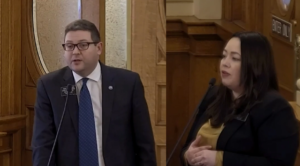Geneva, May 24, 2024
PR/2024/919
WIPO member states today approved a groundbreaking new Treaty related to intellectual property (IP), genetic resources and associated traditional knowledge, marking a historic breakthrough that capped decades of negotiations.
The President of the Diplomatic Conference, Ambassador Guilherme de Aguiar Patriota, who is also Brazil’s Permanent Representative to the World Trade Organization, brought down the gavel to mark consensus approval of the new WIPO Treaty on Intellectual Property, Genetic Resources and Associated Traditional Knowledge . Delegates at the May 13 – 24, 2024 final stage negotiations cheered and applauded the successful outcome.
This is the first WIPO Treaty to address the interface between intellectual property, genetic resources and traditional knowledge and the first WIPO Treaty to include provisions specifically for Indigenous Peoples as well as local communities.
The Treaty, once it enters into force with 15 contracting parties, will establish in international law a new disclosure requirement for patent applicants whose inventions are based on genetic resources and/or associated traditional knowledge. A signing ceremony is scheduled for later today.
Negotiations for this Treaty began at WIPO in 2001, initiated in 1999 with a proposal by Colombia, where discussions were notable for their inclusion of Indigenous Peoples as well as local communities.
WIPO Director General Daren Tang welcomed adoption of the Treaty and congratulated negotiators on the successful outcome of the Diplomatic Conference, noting: “Today we made history in many ways. This is not just the first new WIPO Treaty in over a decade but also the first one that deals with genetic resources and traditional knowledge held by Indigenous Peoples as well as local communities. Through this, we are showing that the IP system can continue to incentivize innovation while evolving in a more inclusive way, responding to the needs of all countries and their communities.”
Mr. Tang added “This agreement by consensus is not just the culmination of a 25 year negotiating journey, but also a strong signal that multilateralism is alive and well at WIPO. I thank all of the negotiators, past and present, who worked tirelessly these last two weeks as well as in the past few decades to make history today.”
Ambassador Patriota called the new Treaty “a very carefully balanced outcome of this Diplomatic Conference. It constitutes the best possible compromise and a carefully calibrated solution, which seeks to bridge and to balance a variety of interests, some very passionately held and assiduously expressed and defended over the course of decades.”
“We’ve been waiting for this moment for 25 years,” said Ambassador Patriota.
What Does the Treaty Do?
Broadly, where a claimed invention in a patent application is based on genetic resources, each contracting party shall require applicants to disclose the country of origin or source of the genetic resources. Where the claimed invention in a patent application is based on traditional knowledge associated with genetic resources, each contracting party shall require applicants to disclose the Indigenous Peoples or local community, as applicable, who provided the traditional knowledge.
What are Genetic Resources and associated Traditional Knowledge?
Genetic resources are contained in, for example, medicinal plants, agricultural crops, and animal breeds. While genetic resources themselves cannot be directly protected as intellectual property, inventions developed using them can, most often through a patent.
Some genetic resources are also associated with traditional knowledge through their use and conservation by Indigenous Peoples as well as local communities, often over generations. This knowledge is sometimes used in scientific research and, as such, may contribute to the development of a protected invention.
What is a Diplomatic Conference?
A WIPO diplomatic conference is typically convoked by a decision of the WIPO General Assembly, which defines the objective of the conference and the general conditions for participation. Diplomatic conferences are governed by their own rules of procedure and customary international law. Accordingly, it is the conference itself that adopts the treaty and a final act.
The diplomatic conference in Geneva was divided into two committees: Main Committee I and Main Committee II.
The first committee’s mandate was to negotiate and agree on all substantive intellectual property provisions and recommend them for adoption by the plenary. The second committee was charged with negotiating and agreeing on all administrative provisions and final clauses, such as who can join the Treaty and the conditions for its entry into force.
Main Committee I was chaired by Ms. Jodie McAlister, General Manager, Policy and Stakeholder Group, IP Australia and Main Committee II was chaired by Ms. Vivienne Katjiuongua, Chief Executive Officer, Business and Intellectual Property Authority (BIPA) of Namibia. Three other committees were also formed: the Credentials Committee, which verified credentials of delegations to participate in the conference and to sign the Treaty; the Drafting Committee, to ensure that the six language versions of the Treaty would be properly aligned; and the Steering Committee, which included the chief officers of all the committees and ensured the process remained on track.
When all committees finalized their work, the treaty was sent to the conference plenary for adoption and then opened for signature. Signing the treaty at the end of a diplomatic conference does not commit a country to being bound by its provisions. It is, however, a strong indication of intent by the signatory. The Final Act – a record that the conference took place – is also open for signature after adoption.
Related Links
About WIPO
The World Intellectual Property Organization (WIPO) is the United Nations agency that serves the world’s innovators and creators, ensuring that their ideas travel safely to the market and improve lives everywhere.
We do so by providing services that enable creators, innovators and entrepreneurs to protect and promote their intellectual property (IP) across borders and acting as a forum for addressing cutting-edge IP issues. Our IP data and information guide decisionmakers the world over. And our impact-driven projects and technical assistance ensure IP benefits everyone, everywhere.For more information, please contact the News and Media Division at WIPO:
- Tel: (+41 22) 338 81 61 / 338 72 24




